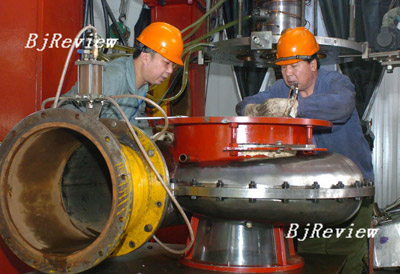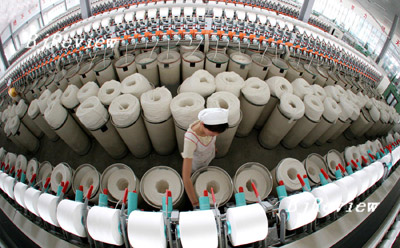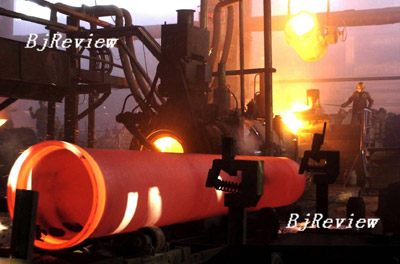
It depends on what industry you're in. Hi-tech, pharmaceutical and other exporting industries are finding cleaner skies than ever before after new trade policies.
But textile exporters are trying to survive a perfect storm of new policies that threaten to sink their business.
"My guess is in 2007, one fifth of the textile companies in Wenling will close," said Liang Qun, Senior Manager of the China Artex Taizhou Import and Export Co. Ltd. in Zhejiang Province, after China cut tax rebates for textile companies 2 percentage points in September 2006.
Wenling, a county of Taizhou, is known for its numerous shoe-making family workshops. Liang's company produces shoes, fabrics and garments, as well as metal tools with annual sales of $10 million.
In order to balance its exports and imports, the Chinese Government has adopted various measures, including adjusting the tax rebate mechanism. As of September 15, China lowered its tax rebate for textile exports from 13 percent to 11 percent.
"We will lose about $15,000 for shoes and fabrics," Liang said. Net profit for every pair of shoes is only 1 yuan in his company.
"Our profit margin is already razor-thin," he said.
Textile industry is hit

"These measures are disadvantageous to export industries of high energy consumption, high pollution and low added value, but favorable to high value-added and hi-tech exports, as well as imports of advanced technology," Mei Xinyu, a trade researcher with the Chinese Academy of International Trade and Economic Cooperation affiliated with the Ministry of Commerce, told Beijing Review.
The textile industry is among the ones that have rough luck. "The tax rebate cut will force more textile companies to go bankrupt," Liang said. The reduction of the tax rebate rate has delivered another blow to the shoe manufacturing industry, which had already been battered by the rising price of raw materials, a higher tax rate and an improvement in workers' compensation.
According to an online poll by Webtextiles, China's first textile portal, more than 65 percent of the 2,200 polled said the tax rebate drop will have a noticeable impact on their companies, while only 17 percent said the impact will be modest. Over 75 percent of the polled are against the 2-percentage-point reduction.
However, some other textile producers are not so worried. Song Yan, Senior Manager of the Violet Home Textile Co. Ltd. in Jiangsu Province, responded calmly to the tax rebate drop. "The policy does not affect us very seriously," she said. Violet Home Textile produces mainly high- and medium-level bed wear sold at department stores in the United States, Canada, Europe and the Middle East, with annual sales of $10 million.
Song predicted that her company would lose at least $100,000 for orders already placed but not yet performed. "We will take the reduced tax rebate into account when pricing future orders," Song said, adding she would put a premium on her products by coming up with new designs and colors.
So the key to dealing with textile woes appears to be increasing value-added aspects of manufacturing and controlling costs. Zhou Jie, an analyst of the textile industry at Everbright Securities Co. Ltd., believes that those companies whose products are competitive with a high added value can offset lost profits by improving price negotiation and transforming their export patterns.
Take Nanjing Textiles Import and Export Corp. Ltd. as an example. According to company secretary Dong Jie, early in January 2006, the company had planned to transform its export strategy by expanding value-added products. On the one hand, it has increased profit margins when accepting orders and, on the other, it has adjusted the export structure by reducing exports of materials whose profit margin is small and expanding exports of finished products with high profits.
Gao Hucheng, Vice Minister of Commerce, also hoped that the Chinese textile industry would speed up adjustment of technology structures, strengthen intellectual property rights protection, establish their own brands and improve core competitiveness so as to achieve the sustainable and sound development of the industry.
Iron and steel industry worries

Beginning September 15, 2006, tax rebates for the iron and steel industry were reduced 3 percentage points, from 11 percent to 8 percent. This was followed in October by the imposition of a 10-percent tariff on overseas shipments of billets, pig iron and ferroalloy. Analysts believe that this adjustment has brought heavier pressure on the industry. Since the iron and steel industry is at the break-even point right now, it is the most sensitive to an adjustment of tax rebates. At present, some of the industry's products are faced with overcapacity. Hence, the selling prices of these products cannot be raised. Together with the price hikes of iron ore and energy on the international market, costs of rolled steel are coming up.
Despite changes in the tax rebate rate, China's steel exports kept surging in 2006 thanks to strong international demand and much higher steel prices on the international market. In 2006, China's exports of rolled steel soared 109.6 percent to 43.01 million tons.
However, Luo Bingsheng, Vice Chairman of the China Iron and Steel Association, predicted that the nation's steel exports in 2007 would plummet as a result of government interference. In his opinion, exports of rolled steel will drop 17.5 percent this year to 33 million tons.
Liu Shuiyang, Vice President of the Shougang Group, China's fifth largest steel mill, said his company's steel exports would be affected this year by the government's curbs. He expects to sell 1.5 million tons of rolled steel abroad this year, down from the 2 million tons estimated last year. According to him, the biggest foreign destination for the firm's rolled steel is North America, with an annual export volume of 500,000 tons in recent years.
High value-added exports welcome changes
In order to encourage high value-added industries and emerging industries, the state increased the refund rate for specific technological equipment, IT products and biological and medical products by 4 percentage points to 17 percent, while those of agricultural products were raised 2-8 percentage points to 13 percent.
"This shows that the government attaches importance to both development and stability, for mechanical and hi-tech products are the future of our industrial development," said Mei Xinyu. "Increasing the tax rebate rate for agricultural products also aims at stability."
Industry insiders believe that the increase of tax rebates for mechanic and electrical products will help the development of the industry. On the one hand, the increase of the refund rate can cut export costs of these products and promote improvement of the product mix and industrial structure. Raising the tax rebate particularly for power generation equipment should help with their exports.
On the other hand, since rebate rates for most rolled steel are reduced 3 percentage points and those for non-ferrous metals are cut by 2-8 percentage points, more materials for mechanical and electrical products may be sold in the domestic market. Reducing the tax rebate rate for rolled steel and non-ferrous metals will intensify competition in the domestic market, and thus, knock down prices of raw materials. The result is a reduction in costs of mechanical products and an improvement in their economic returns.
The tax rebate increase of biological and medical products is also believed to encourage their exports. "With the increase of export refunding, international competitiveness of Chinese pharmaceutical companies can be improved," said Jiang Zhenwei, General Manager of the Shanghai Medicines and Health Products Import and Export Corp.
According to him, the strongest rival of China's pharmaceutical industry is India, which returns all the tariffs it collects from medicine exporters. At present, the average quotation of exported medicines by Chinese companies is lower than the average price on the international market. If the exporters can get more tax rebates, they can offer lower quotations for exports.
However, industrial insiders may not be satisfied with the 4-percentage-point tax rebate increase. "Actually tax rebates for all medical preparations should be raised since the country's exporting volume is not large. A 4-percentage-point increase of tax rebates will not impose a significant burden on the government, but companies will benefit a lot," said an anonymous official of the China Chamber of Commerce for Import and Export of Medicines and Health Products.
Since the rise of tax rebates has been adopted for only a few months, companies cannot yet estimate the exact benefits, but many still figure that they will benefit from the policy.
"This shows the country's encouragement of medicine exports," said Chen Qiyu, Executive Vice President of FOSUN Pharmaceuticals (Group) Corp.
| 